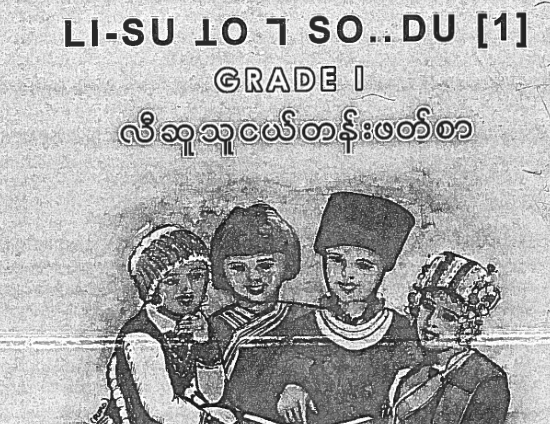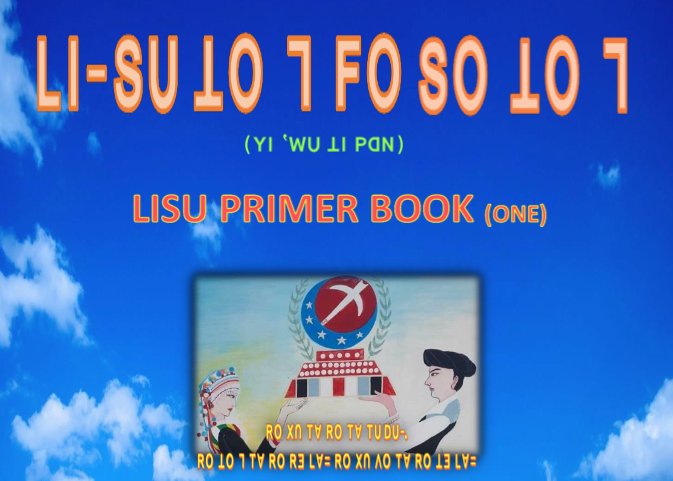ꓡꓲ‐ꓢꓴ ꓕꓳ ꓶ ꓢꓳ, ꓣꓴ ꓓꓴ ꓕꓳ ꓶ ꓑꓷꓠ (ꓑꓓꓝ File ) BE Video Lesson ꓢꓳ ꓚꓱ, ꓔꓯ ꓧꓪ, ꓣꓴ ꓠ, ꓟ ꓐꓱ ꓶ ꓙꓽ ꓘꓪ ꓗꓪ ꓡꓲꓠꓗ ꓖꓶ ꓔ ꓡꓳ꓿

(ꓲ) ꓕꓱ ꓟ ꓠꓬ ꓟꓬ‐ꓟ ꓗꓴꓷꓼ ꓡꓲ‐ꓢꓴ ꓡꓲ ꓒꓰꓼ ꓜꓴ ꓚꓰꓼ ꓗꓪ ꓐꓰ ꓫꓬ ꓔ ꓟ ꓥꓳ꓿
1. Grade 1 PDF File From Myanmar
2. Grade 2 pdf File From Myanmar
3. Grade 3 pdf File From Myanmar.
Lisu Language Center of Texas (LCCT) ꓗꓪ ꓐꓰ ꓙ ꓖꓶ ꓔ ꓟ ꓦꓲꓓꓰꓳ
(ꓲꓲ) ꓕꓱ ꓟ ꓠꓬ ꓡꓲ‐ꓢꓴ ꓮ‐ꓟꓰ‐ꓣꓲ‐ꓗꓮꓠ ꓜꓴ ꓾ ꓕꓳ ꓶ ꓐꓰ ꓡꓲ ꓒꓰꓼ ꓜꓴ (Cultural & Literature Department, LAA) ꓗꓪ ꓐꓰ ꓫꓬ ꓔ ꓟ ꓥꓳ꓿
- ꓡꓲ‐ꓢꓴ ꓕꓳ ꓶ ꓝꓳ ꓢꓳ ꓕꓳ ꓶ (1) Lisu Primer Book (1) pdf File
- ꓡꓲ‐ꓢꓴ ꓕꓳ ꓶ ꓝꓳ ꓢꓳ ꓕꓳ ꓶ (2) Lisu Primer Book (2) pdf File
- Video

(III) ꓕꓱ ꓟ ꓠꓬ ꓟ. ꓒ ꓐꓬ ꓬꓳ‐ꓢꓷ (ꓚꓮꓠꓮꓓꓮ) ꓗꓪ ꓐꓰ ꓫꓬ ꓔ ꓟ ꓡꓲ‐ꓢꓴ ꓕꓳ ꓶ ꓝꓳ, ꓢꓳ ꓣꓴ ꓓꓴ ꓕꓳ ꓶ ꓑꓷꓠ ꓥꓳ꓿

(IV) LI‐ꓢꓴ ꓫꓵꓽ ꓚ ꓟꓲ ꓬꓲ ꓟꓳ ꓡꓱ ( A Brief History of Lisu) By Rev. Dr. La Wu
A Brief History of Lisu
by Rev. Dr. La Wu
1. Like other nations of Asia, Lisu also traces their history back to Mongolia. Their forefathers were
known as warriors. Even until recent time, traditional men’s dress is seen as designed to be a
warrior. It can be assumed that sometime around 500-400BC they moved down to China and
settled down around Nanjing Jiangxi area. The proof is that Lipo, an ethnic group branched out
from Lisu after severe war with Ming dynasty, professed that their militant forefathers were
originated from Nanjing Jiangxi area of Eastern China.1 In Chinese history, crossbow (the main
weapon of Lisu) was found using from 342 BC.2
By looking at the similarities of Lisu language and culture with other neighboring groups,
Western historians group them together with Tibeto-Burman groups deriving from Tibet. In
deed Lisu is a group of people easily can adopt neighboring language and culture. Therefore one
cannot easily finalize like Western historians do. For instance, now after hundreds of years the
Lisu living in Thailand use many terms adopted from Thai but one cannot group them together
with Thai. The fact that there are more similarities of Lisu Language and culture with that of
Chinese and Japanese inevitably shows that these three groups lived many years somewhere
adjacently as they moved down from Mongolia. Here is just a hint how Lisu and Japanese are
closed to each other in Language.
1. For numeral One, Two, Three
Japanese: Ichi Nyi Sang
Lisu Thi Nyi Sa
2. For the word “ Twenty two thousand”
Japanese: Nyi Ju Nyi Man
Lisu: Nyi Tzi Nyi Moen
3. For the word “Thanks” 4. For The Word “Not Yet”
Japanese: Do Mo Ma Da
Lisu: Xa Mo Ma Da Se
2. There is an oral story of conflict between Lisu King and Chinese king over the fertile land. The
story says that the out beaten Chinese king deceitfully drove Lisu king and his people to Western
mountainous regions by creating a power contest. This could not be later than 221 BC when Qin
dynasty conquered all warring kings and centralized the authority.3 There were believed to be
more than 150 different language groups driven to the western parts by Chinese kings.4
The power contest between the two kings as handed down among Lisu was conducted at the
Chinese palace. They agreed to set their royal staffs ceremoniously in the middle of the palace
and give oath in front of their people saying that let the staff of the king who has power to
remain in the fertile land bear golden flowers during the night, and the loser has to move away
to the West. The confident Lisu king slept soundly the whole night but, reckless Chinese king
peeped in the spot every now and then without sleep. After midnight when Chinese king saw
the rod of Lisu bearing golden flowers he sent in the best slicker and exchanged the staffs. At
the down Chinese king and his people celebrated the victory but Lisu king and his people, being
honest and full of integrity, silently and sorrowfully moved toward the West. Ever since then
after they found out that they were cheated, there is a circulated saying among Lisu,
“Kei. kei. Hei Pha hwa, se se Lisu hwa” meaning,
“In cheating Chinese are glorious, but in fighting Lisu are victorious.”
On the other hand, there is an hypothesis that Lisu King and his people were driven by Chinese
king because they helped Alexander the Great in conquering Genghis Khan in 330 BC. This seems
to be that Alexander, the most intelligent warrior saw the military skill and power of Lisu
warriors and captured them first and utilized them in defeating Mongolian emperor.
3. The conflict between Chinese and Lisu continued as the Chinese emperors extended their
sovereignty to the West. Under Ming dynasty (1368-1644AD) the chase after Lisu King and his
people was severe because Lisu seemed to remain as one of the stronger antagonists. As
Chinese military power increased tremendously while Lisu’s is weakening, the more they fought
the more they were defeated and dispersed into different directions.
Many, after hundreds of years were assimilated into Chinese and no longer claim as Lisu except
Lesu still living in the high lands of Xing Ping, Jing Ping, Zhen Yuan, and E-Shan prefectures of
3 Timeline of Chinese history From Wikipedia, the free encyclopedia )
4 National Geographic Magazine March 1971Yunnan Province; Gaisu known as white Lisu living in Gei Jiu and Yong De prefectures of Yunnan;
and Lipo known as Eastern Lisu living in Yong Ren, Yuan Mau, Bin Chuan, Yao An and Yong Shen
prefectures of Yunnan Proveince and Pan Zhi Hua prefecture of Si Chuang province.5 There are
two groups of Lipo today. Western Lipo seemed to branched out from Lisu earlier than the
Eastern Lipo, because they have more deviated language and costumes, but they still have
reminiscence of their past history. Eastern Lipo the group closer to Lisu are believed to diverge
after the final war with Qing dynasty in 1801-1803.6 But since they do not inherit the
celebration of sword ladder climbing which was originated with the victory of Qing Dynasty over
Ming dynasty, they could also be parted in late Ming dynasty era.
Ming emperors, being cruel to them, Lisu helped Qing emperor and overthrew Ming Dynasty in
1644AD. At the victory celebration Lisu warriors showed up their military might by climbing
sword ladder on bare foot. Ever since then even until now sword ladder celebration is
conducted in every New Year.7
In early part of Qing dynasty Lisu were given favor and allowed to serve in royal army and each
year a roll of cloth was given to each soldier as wages, and their wives stitched colorful dresses
out of different colored cloths their husbands brought. But in later period due to heavy taxation
Lisu began to resent against the royal decrees and there broke out series of war again.
4. In 1801-1803AD, the final war was launched with more than 10,000 Chinese army selected from
three provinces. The historian made a note to this war, “Using cattle knife to kill chicken.”8 It
looks like a war of total annihilation, but Lisu were able to survive in the most difficult lands with
steepest rocky mountains and deepest canyons between the beds of Salween, Mekong and
5 http://joshuaproject.net/search.php
6 http://www.joshuaproject.net/people-profile.php
7 http://www.articlesbase.com/home-business-articles/lisu-people-2886837.html
8 Lisuzu Jianshi: A Short History of Lisu (Kunming, 1983)39Yangtze rivers located at the West end part of Yunnan province even though Chinese cut off the
road for years and years after. Even in such situation Chinese government imposed heavier tax
and it is written that in 1940, Lisu had to pay tax for 65 different categories and the most
meaningless tax was paying two taels for each time Chinese air plane flew over Lisu land. 9
5. Having this long span of bitter experience, after living in unreached higher lands for years and
years the Lisu once known as great warriors had turned into poor and degraded taciturn people
unwilling to be bothered by any people or government thereby becoming neglected or less
attended by their respective countries. Within and after the warring period with Qing dynasty
Lisu moved along the mountain ranges into Burma and Thailand. After military coup over taken
the country in 1962, some Lisu living in Putao area of Myanmar moved into Northeast of India.
Nowadays, due to military oppression and local wars Lisu from Myanmar spread into different
parts of the world through United Nation refugee program.